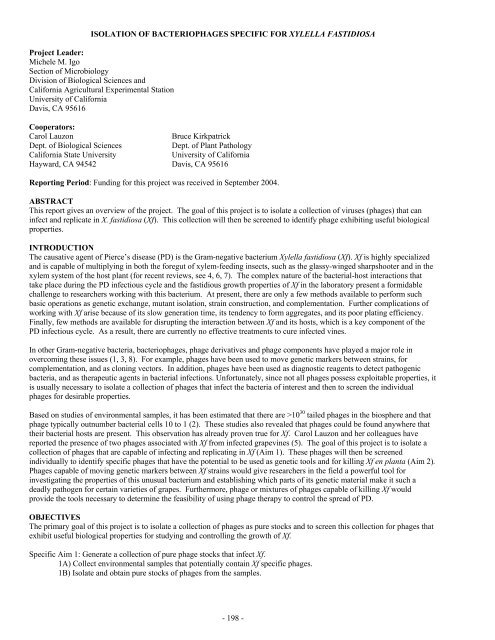Impact Of Host Plant Xylem Fluid On Xylella Fastidiosa Multiplication ...
Impact Of Host Plant Xylem Fluid On Xylella Fastidiosa Multiplication ...
Impact Of Host Plant Xylem Fluid On Xylella Fastidiosa Multiplication ...
You also want an ePaper? Increase the reach of your titles
YUMPU automatically turns print PDFs into web optimized ePapers that Google loves.
ISOLATION OF BACTERIOPHAGES SPECIFIC FOR XYLELLA FASTIDIOSA<br />
Project Leader:<br />
Michele M. Igo<br />
Section of Microbiology<br />
Division of Biological Sciences and<br />
California Agricultural Experimental Station<br />
University of California<br />
Davis, CA 95616<br />
Cooperators:<br />
Carol Lauzon<br />
Dept. of Biological Sciences<br />
California State University<br />
Hayward, CA 94542<br />
Bruce Kirkpatrick<br />
Dept. of <strong>Plant</strong> Pathology<br />
University of California<br />
Davis, CA 95616<br />
Reporting Period: Funding for this project was received in September 2004.<br />
ABSTRACT<br />
This report gives an overview of the project. The goal of this project is to isolate a collection of viruses (phages) that can<br />
infect and replicate in X. fastidiosa (Xf). This collection will then be screened to identify phage exhibiting useful biological<br />
properties.<br />
INTRODUCTION<br />
The causative agent of Pierce’s disease (PD) is the Gram-negative bacterium <strong>Xylella</strong> fastidiosa (Xf). Xf is highly specialized<br />
and is capable of multiplying in both the foregut of xylem-feeding insects, such as the glassy-winged sharpshooter and in the<br />
xylem system of the host plant (for recent reviews, see 4, 6, 7). The complex nature of the bacterial-host interactions that<br />
take place during the PD infectious cycle and the fastidious growth properties of Xf in the laboratory present a formidable<br />
challenge to researchers working with this bacterium. At present, there are only a few methods available to perform such<br />
basic operations as genetic exchange, mutant isolation, strain construction, and complementation. Further complications of<br />
working with Xf arise because of its slow generation time, its tendency to form aggregates, and its poor plating efficiency.<br />
Finally, few methods are available for disrupting the interaction between Xf and its hosts, which is a key component of the<br />
PD infectious cycle. As a result, there are currently no effective treatments to cure infected vines.<br />
In other Gram-negative bacteria, bacteriophages, phage derivatives and phage components have played a major role in<br />
overcoming these issues (1, 3, 8). For example, phages have been used to move genetic markers between strains, for<br />
complementation, and as cloning vectors. In addition, phages have been used as diagnostic reagents to detect pathogenic<br />
bacteria, and as therapeutic agents in bacterial infections. Unfortunately, since not all phages possess exploitable properties, it<br />
is usually necessary to isolate a collection of phages that infect the bacteria of interest and then to screen the individual<br />
phages for desirable properties.<br />
Based on studies of environmental samples, it has been estimated that there are >10 30 tailed phages in the biosphere and that<br />
phage typically outnumber bacterial cells 10 to 1 (2). These studies also revealed that phages could be found anywhere that<br />
their bacterial hosts are present. This observation has already proven true for Xf. Carol Lauzon and her colleagues have<br />
reported the presence of two phages associated with Xf from infected grapevines (5). The goal of this project is to isolate a<br />
collection of phages that are capable of infecting and replicating in Xf (Aim 1). These phages will then be screened<br />
individually to identify specific phages that have the potential to be used as genetic tools and for killing Xf en planta (Aim 2).<br />
Phages capable of moving genetic markers between Xf strains would give researchers in the field a powerful tool for<br />
investigating the properties of this unusual bacterium and establishing which parts of its genetic material make it such a<br />
deadly pathogen for certain varieties of grapes. Furthermore, phage or mixtures of phages capable of killing Xf would<br />
provide the tools necessary to determine the feasibility of using phage therapy to control the spread of PD.<br />
OBJECTIVES<br />
The primary goal of this project is to isolate a collection of phages as pure stocks and to screen this collection for phages that<br />
exhibit useful biological properties for studying and controlling the growth of Xf.<br />
Specific Aim 1: Generate a collection of pure phage stocks that infect Xf.<br />
1A) Collect environmental samples that potentially contain Xf specific phages.<br />
1B) Isolate and obtain pure stocks of phages from the samples.<br />
- 198 -











